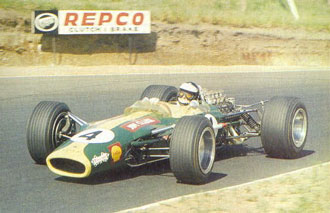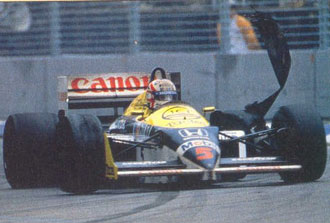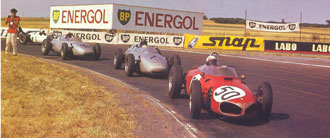|
| |||
 |
The Best Season Ever Elaborate Comparison Between All Seasons | ||
| by Peter Goodchild and David Southworth, England | |||
|
Following the recent rash of millennial lists, you are probably groaning at the prospect of yet another F1 ranking. We have seen lists of teams, drivers, races, circuits, engines even. But precious few lists of Grand Prix seasons. Most lists are subjective assessments by motor sport pundits. A few are abstruse statistical affairs which seek to baffle more than explain. The former suffer because, more often than not, they reflect more on the pundit than the subject matter. The latter because they all too often become turgid lists of numbers. Although there are oceans of statistics, it is all too easy to drown in minutiae.
What follows is a bit different. We hope it will be fascinating purely because it is so difficult to define exactly what makes a good season. We have adopted a statistical approach and have attempted to rank the Grand Prix years in order of quality. That way we hope to iron out biases introduced by the intensity of media coverage of recent years in comparison with the early years, and by the first hand experience of various commentators. The writers themselves are familiar only with racing from the mid-1970's onwards, yet are confident that this bias will not be reflected in the ranking. But as we have said, statistics are often a turn-off because they present history in black and white. We will try to add a little colour to this picture. We aim to reflect the following types of factor:
This study should be read in conjunction with the statistics table. We are aware that other factors might be taken into consideration, but (as described in the Methodology) we baulked at compromising the objectivity of our study. We hope you have as much fun reading and criticising our study as we have had attempting it.
Fifth: 1968
But its most famous race did little to help 1968's score. The 14 miles of the old Nurburgring were shrouded in mist and flooded with standing water. Jackie Stewart, starting sixth, led by the end of the first lap and won by 4 minutes from Graham Hill. Fourth: 1986 This score surprised us and probably also surprises you. The mid-80's are often written off as an era of turbo domination when races became tedious because of the huge superiority of McLaren and then Williams. 1986 was the transition year between these two phases. The TAG Porsche engine was losing its lead to the Hondas powering the Williamses. But McLaren now focused on Alain Prost (as Rosberg was unable to compete), whilst Williams allowed their drivers to fight amongst themselves, contriving to lose the Drivers' Championship to Alain Prost whilst winning the Constructors' by 45 points. The year will always be remembered for those flickering images beamed across the globe from Adelaide to a disbelieving public, as Mansell, cruising to the championship, manfully brought his car to a halt when a tyre exploded at 190mph on the Dequetteville straight.
Third: 1999 1999 really has done extraordinarily well. Even without the inclusion of political intrigue as a factor (which might have boosted it to 2nd), last year gets 58 points. Why? Eddie Irvine, Michael Schumacher and Mika Hakkinen's combined attempts to lose the World Drivers' Championship allowed 8 championship lead changes. We will all remember how no one seemed to want to win the title during the second half of the season. Most tellingly, race finishes have been extremely close. We are constantly being told that the racing is not close any more. Poppycock. The current formula is maturing into one where chassis are very evenly matched, possibly a result of the restrictive regulations in that area. Of course cynics might point out that the Canadian GP saw 6 finishers within 5 seconds of Mika Hakkinen at the finish because of the late withdrawl of the pace car. Who can say that such a race finish was not exciting? Second: 1961
OK, so there was little variety - this was to be expected in a Formula which nearly spawned a breakaway Intercontinental championship. Constructors showed scepticism about its validity as the apotheosis of worldwide motor racing. But there were five different winners in 8 races- in comparison 1999 saw 5 winners in twice that number of events. The championship lead changed hands 5 times. And the races themselves are revealed to be classics. The average winner started from between 4th and 5th on the grid (The average starting position for winners over all 635 non-Indy races is just under 3rd). There were over 6 lead changes per race in an era where fuel or tyre stops were uncommon. Races frequently had close finishes. This insight is enhanced by a look at two of 1961's races. The year started with Stirling Moss, in an underpowered and outdated Lotus keeping the superior Ferraris at bay around the Monegasque confines. At the French GP the privately-entered Ferrari of Giancarlo Baghetti squeaked to a 0.1 second victory over Dan Gurney's Porsche. Giancarlo Baghetti was competing in his first Grand Prix. This feat has never been repeated. First: 1982 So there we have it, the best ever season of F1, as ATLAS F1's Don Capps has already established, can now be confirmed as 1982. Just to remind you, here are its full vital statistics:
1982 has a four point cushion over its nearest rival, 1961, and scores extremely highly overall. The reason was because the championship was close-fought and there were 11 race winners. There was also much strength in depth with winners starting low on the grid (e.g. John Watson won from 17th on the grid at Detroit) and many individuals scoring points because of the high driver turnover.
But despite this, the statistics hide other dramas that year: the "drivers' strike" in South Africa; the disqualification of Piquet and Rosberg to allow third-placed Alain Prost to win the Brazilian GP, the FOCA "boycott" of the San Marino GP, and the ferocious battle during that race between Pironi and Villeneuve, capped by Villeneuve's chilling promise never to speak to Pironi again. The tiny margin of victory of De Angelis over Rosberg in Austria, and Watson's amazing "burns from the stern" both added to an amazing year and have influenced the statistics.
And then there was Monaco. When 1999 was the Championship no one wanted to win, this was the race no one wanted to win. Prost, Patrese, Pironi, Andrea De Cesaris and Derek Daly all treated the lead like a hot potato. Daly nearly won with all the wings knocked off his Williams!
46th: 1957
1957 was the year of Juan Manuel Fangio's last world championship. And a pretty dominant affair it was too. He led all the way and won the title with a race to spare. The races were generally uncompetitive, with few close finishes and the average winner starting from the front row. There were only three winners. The championship suffered from a lack of variety, with 6 constructors participating and 17 points scorers.
This year demonstrates that a great race does not a great year make. Indeed, the British and German GPs both involved high drama with, respectively, Moss (in a Vanwall) and Fangio (Maserati) making up huge deficits to win either race.
47th: 1963
Jim Clark won 7 of the 10 races in 1963, clinching his first title with three remaining. The year ranks poorly for closeness of race finishes, despite having the use of a Monza unblemished by chicanes. The average winner started around second on the grid, and there were but 17 points scorers. This was one boring year.
48th: 1988
We believe that this year starkly demonstrates the differences between an objective and a subjective approach. Jo Ramirez once said that 1988 was a classic GP season because it constituted a "match race" between the two best drivers in identical, superlative, equipment. Yet it lies 48th in our ranking. McLaren team mates Prost and Senna won 15 of 16 races. The year was remarkable because of their titanic struggle and because of the race they did not win, The Italian GP at Monza, a Ferrari 1-2 just weeks after Enzo Ferrari's death. A season cannot be remembered because of the drama in one race alone
But looked at objectively, the season saw only 3 winners and even this statistic flatters the duopoly that was 1988. Despite the struggle, Ayrton Senna managed to wrap up the championship at Suzuka, the penultimate round. The lead changed on average just over once per race. Unsurprisingly the average winner started from the front row and no new teams powered their drivers to the winner's rostrum. Looked at objectively, this was far from a classic season, and it is not surprising that viewing figures did not rocket in 1988.
49th: 1992
In 1992, Mansell won a mere 9 of 16 races, including 8 of the first 10. He had another 3 second places and did not finish any other race. On pole 13 times, he also recorded 7 fastest laps. Mansell's team, Williams, won the Constructors' Championship by 65 points. The championship could not have been less competitive. Another dominant season.
Last: 1952
In 1952, Alberto Ascari won each of the 6 GPs he entered (of 7). He recorded fastest lap each time, and was on pole for all races except the British GP, where he was second. This was true domination.
1963, 1992 and 1952 are historic for their sheer one-sidedness. One of the problems with this analysis is that some years are remarkable because they are so predictable. Indeed, when records are threatened, even domination can become enthralling.
In Quality Order:
Click here to see the full statistics table
We have selected 1986, 1988, 1994, 1996 and 1999 as our most surprising results from the recent era. Some are dealt with in depth in the Best and Worst lists above. 1986 and 1999 are surprisingly high, even though neither had the benefit of the "Monza Boost", described below, neither had battalions of teams or points scorers, or exceptionally high numbers of winners.
1996
Murray Walker famously had to stop talking "because I have a lump in my throat". We all felt a profound sense of historical reconciliation as Damon Hill joined his father in the pantheon of World Champions. For British viewers, most of us enjoyed each one of the seven races won by Damon Hill. But the year was otherwise unremarkable, ranking only 39th in our study. Despite the championship going to the wire, Hill was ahead all season. There were only 4 winners and 16 point scorers. The average winner started from 3rd or higher.
There were only two notable races. The Spanish GP saw Michael Schumacher in his Neanderthal Ferrari consign 25 other world class drivers to kindergarten, sometimes lapping four seconds quicker than them in monsoon conditions. The Monaco GP defied belief for anyone who watched it, but only 3 cars crossed the finish line, Olivier Panis' Ligier being the first.
1994
1994 will be remembered as a monumental year in F1 history. We saw the final throes of the old order, replaced brutally by a new breed, perhaps before the world was ready to say goodbye to the old.
Michael Schumacher opened up a huge championship lead, only for Damon Hill, with more than a little help from the FIA, to close it down to one point. We saw the horrors of Imola and Monaco, and then kneejerk safety measures. Mansell returned, to win the final race. Coulthard came on the scene, seemingly destined for greatness. There was that fantastic, enthralling, duel between Michael and Damon in Suzuka.
And yet in our study it ranks only 29th. It is let down because it had only 4 winners, the championship lead remained with Schumacher from Brazil to Australia, and the average winner started from the front row- hardly a recipe for on-track excitement. Our statistics clearly provide a skeleton of analysis, but the flesh and blood of intrigue, drama and politics is unmeasurable.
The Monza Boost
We could not simply ignore these races, but they clearly have had a profound influence on the scores for "Average number of lead changes". But why should this measure be ignored because of these races? Maybe, earlier seasons were at an advantage because they used more exciting circuits. We do not think this is an artificial aberration.
The 1950's - Les Grandes Equipes stifle Les Grandes Epreuves
Alfa, Ferrari, Mercedes. Names which inspired passion. Farina, Fangio, Moss - those evocative symbols of a classic era. But was the racing any good? Not spectacularly so. It was an era of the conventional, when variety played second fiddle to tradition and great constructors. And even most private entrants usually used cast-offs from those giant factory concerns. In some Grands Prix there were numerous local teams and drivers, but the results were monopolised by the few.
The 1960's - The Racing Purist's Dream Era
Our rankings do not fully support the "accepted view" that the 1960's were the classic era of F1. Yet it is possible to reconcile the approaches. The purists focus on racing. Close races, even fields, lead changes. And their assumptions are indeed borne out, as the 1960's lead the other eras in terms of these factors. The 1980's, fascinating from the historical, championship, perspective, flounder as the worst racing decade. But as we have insisted in this article, close racing is not the be-all-and-end-all of a classic year.
The 1970's - Decade of Variety
The 1970's score superbly on variety, i.e. number of winners, point scorers, maiden constructor wins and number of constructors. Unsurprisingly the 1950's era of manufacturer dominance, and the 1990's era of corporate dominance and the law of lucre both rank low on these factors. In the 1950's the championship was establishing itself and for much of the decade only the manufacturer-backed teams were in a position to impact on results. In the 1990's, generally, it became prohibitively expensive for all but the richest to participate and succeed.
The 1980's - Classic Championship Battles
Often derided as a decade of turbocharged tedium, the 1980's produced four of the top ten years. The early and middle years of the decade show a spectacularly close series of championships. Much of this is due to the maturity of the 3 litre/1.5 litre formula, and the degree of technical equality among top cars, despite the significant increases in power over the period. However, it is important to stress that many of the championships had their own freakish circumstances.
The 1990's - Form over Substance?
The hype was deafening, and the technology was fascinating. But our study shows that the racing was generally poor and, after an initial attempt to make racing more affordable, small teams suffocated through lack of funds, and success once again became the preserve of the wealthy. Variety was dying. In fact, with the exceptions of 1997 and 1999 every year languishes in the bottom half of our overall rankings.
6. Conclusions
There are some features which cannot be objectively measured. We have adopted the approach that, for once, such matters should not be measured, and that we should divorce our analysis from giant personalities or political shenanigans.
At the risk of harping, we can glean two important lessons:
The main conclusion is possibly the easiest no-brainer of them all. And that is that by far and away the best GP year to date was Nineteen Hundred and Eighty Two. Amen.
|
| David Southworth and Peter Goodchild | © 2000 Kaizar.Com, Incorporated. |
| Send comments to: david.southworth@dfee.gov.uk | Terms & Conditions |





 But after two decades of general decline, average lead changes have begun to climb again. Without doubt this is due to the reintroduction in 1994 of pit stops for fuel. The debate, as to whether this has added spice or destroyed the purity of the racing, has raged as powerfully as the fire around Verstappen's Benetton in the pitlane at Hockenheim in 1994. Max Mosley would have us believe that strategy is that je ne sais quoi that makes Formula 1 the most sophisticated motorsport in the World. It certainly adds something, but does it merely disincentivise overtaking on the track until the final pitstops are over?
But after two decades of general decline, average lead changes have begun to climb again. Without doubt this is due to the reintroduction in 1994 of pit stops for fuel. The debate, as to whether this has added spice or destroyed the purity of the racing, has raged as powerfully as the fire around Verstappen's Benetton in the pitlane at Hockenheim in 1994. Max Mosley would have us believe that strategy is that je ne sais quoi that makes Formula 1 the most sophisticated motorsport in the World. It certainly adds something, but does it merely disincentivise overtaking on the track until the final pitstops are over?